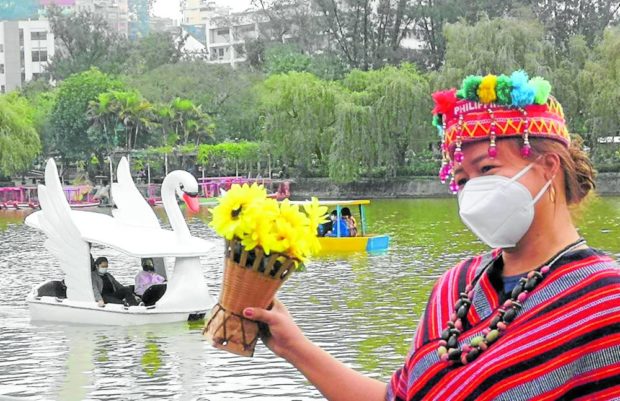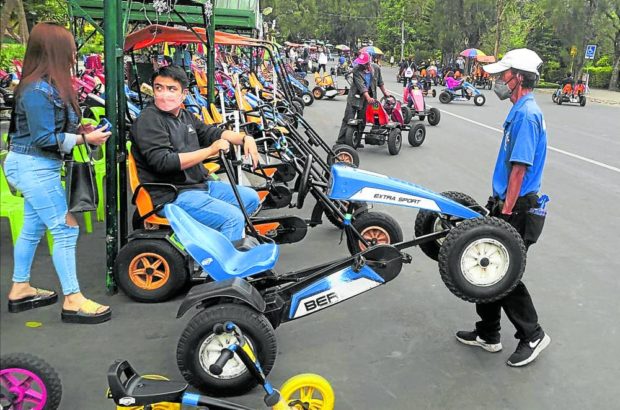Baguio still has room for tourists, but resources dwindling – DENR

STRIKE A POSE Baguio City has been slowly recovering from the impact of the pandemic as tourists start returning to the summer capital after travel restrictions have been eased. —EV ESPIRITU
BAGUIO CITY, Benguet, Philippines — The summer capital has yet to breach its carrying capacity for tourists and may be able to accommodate 679,683 more visitors on top of the 1.53 million tourists it hosted in 2019, data from the Department of Environment and Natural Resources (DENR) showed.
The figure was based on the DENR’s Watershed and Water Resources Research Development and Extension Center (WWRRDEC) computation of the city’s tourism threshold of 2,215,141 guests each year.
But the city government should make trips to the city “more expensive” to trim down on tourist traffic without jeopardizing the income derived from this industry, because other resources like roads and water are no longer sufficient for the Baguio population, said WWRRDEC head Helen Madumba at a briefing on Wednesday.
Carrying capacity refers to the quality of life of a given population when measured against a community’s limited resources. The fewer resources become available, the poorer life becomes for individuals or families.
The DENR focused on Baguio tourism because of its “ripple effects” on the environment and the rest of the public sector, said Ralph Pablo, the DENR Cordillera director, when the study, which was completed in December last year, was presented at the same briefing.
Article continues after this advertisementFor instance, most roads leading to 12 popular Baguio spots have “reached their maximum transport carrying capacity,” Madumba said, matching the findings of the 2019 Baguio urban carrying capacity study commissioned by the National Economic and Development Authority.
Article continues after this advertisement
POPULAR RIDE Among the most popular spots for Baguio tourists, adults and children alike, is the biking area at Burnham Park. Baguio, even amid the pandemic, has seen a steady increase in the number of leisure travelers. —EV ESPIRITU
Congestion
“For the projected population in 2021, there is already a deficit estimated at 325.78 kilometers [per individual], which means the inadequacy of roads will result in more traffic congestion [that would increase] air pollution,” she said.
The DENR study computed the physical carrying capacity for Baguio houses at 57,063, but the number of households had actually grown to 89,987 by 2015, which explains the growing demand for resources and government services for which visitors will compete.
Madumba said the study measured the population’s irritation index, and concluded that “the loss of euphoria” and the growing antagonism against tourists may affect Baguio’s decision to continue to pursue tourism as a primary industry.
The study has established that trees and plant populations, which need to be preserved, “are found in places less visited,” and are therefore not subjected to harm or disturbances from tourists, she said.
A DENR inventory estimates that Baguio trees number about 2.5 million, counting the city’s remaining 500,000 Benguet pine trees, which are clustered at Camp John Hay, Forbes Park and Fort del Pilar, the campus of the Philippine Military Academy.
Baguio environmental officer Rhenan Diwas said 9,000 saplings have been planted in local parks to improve the city’s forest cover. But the agency also discovered that the city had put up too many tourism-oriented establishments.
Cap on hotels
The threshold for Baguio tourism facilities has been breached by 1,444 structures, Madumba said, but she did not reveal the total number of tourist accommodations operating in the city when the study was conducted.
She said regulating the construction of future Baguio tourism structures might be practical, because of a possibility that some of these would lie on sinkholes or would be vulnerable to landslides after storms.
But since February last year, the Baguio government has made policy decisions on construction projects based on the analysis of zoning, geohazard and calamity maps.
For example, the city government has determined that only 11.03 percent of the city’s commercial properties are within unstable areas, and the city’s only economic zone stands on land that is least affected by landslides and other natural disasters.
RELATED STORIES
With no space left, Baguio buys land in nearby towns
Baguio’s gains, losses in modern charter